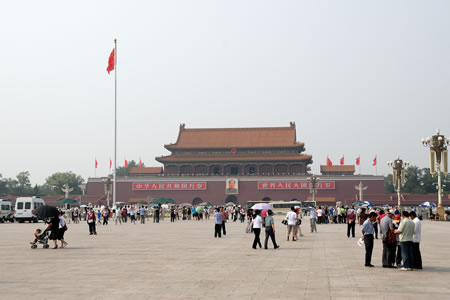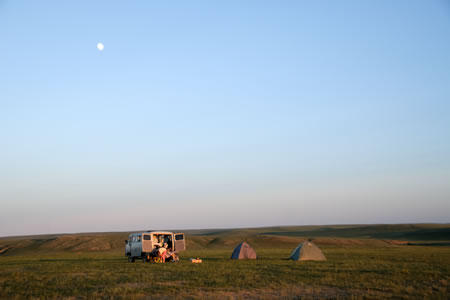English | Dutch |
|
| In the footsteps of Chinggis Khaan | |
Xīníng (China) to Sainshand (Mongolia), June 2010 |
|
By spending 22 hour in a sleeper train, we exchange Xīníng for Bĕijīng. This is the first time that we visit the Chinese capital and we stay in a small guesthouse near Tiananmen Square. Bĕijīng got a complete facelift before it hosted the Olympic Games. Many of the old “hutongs” (alleys) are rebuilt with help of heaps of cement. They have tried to rebuild the houses in the old, traditional style but most alleys lack the atmosphere that they were famous for in the past. The people of Bĕijīng have also had a crash course “good manners”. Spitting in public is frowned upon and jumping the queue when getting on the bus is actively discouraged by “row managers” that use the full force of their megaphone to keep the passengers in line. Still, Bĕijīng is a real piece of China. You can’t change a society overnight. At a small restaurant near our hotel, a three year old boy doesn’t hesitate to urinate in the entrance of his father’s restaurant while his dad is watching. His urine sputters are reaching the steamed dumplings that his father tries to sell! We are using our time in Bĕijīng usefull. The visa of Mongolia has to be arranged and we are emailing and surfing the internet to determine what we want to do when Ivonne’s parents are visiting us in a few months. The visit to Tibet, as well as the trekking in Nepal that we want to do, has to be arranged through a travel agent; so we need to do some research on forehand. When we get into Mongolia, we won’t have much internet access and after we leave Mongolia, we only have a few days left before the “Vlierden 4” arrive. The Vlierden 4 may sound like a bobsled team, but they are a group of four youngsters (between 17 and 19 years old) from the surroundings of the small Dutch town Vlierden, who will travel with us for five weeks through China. During this period we have better things to do than surfing the internet. We are looking forward to the time with Anne, Fay, Joris and Sten. Travelling with people who haven’t been to the region before make you more aware of things that are now obvious for us. |
|
 |
|
The Tiananmen Square in central Beijing |
|
| We break up the route to Ulaan Baatar (capital of Mongolia) in several stages. By bus, we travel via Hohhot to Èrlián at the Chinese side of the Mongolian border. Per jeep, we cross the border and thereafter we take the local train to Ulaan Bataar. (See also the article: Spooning with a stranger) In Ulaan Baatar we immediately try to find a tour agency that can organise a trip to Eastern Mongolia and the Gobi dessert. After a lot of reading we have decided to concentrate on these parts of the country. Also the Northern and the Western parts of the country must be beautiful, but we think we have seen more similar mountainous landscapes elsewhere. Eastern Mongolia is seldom visited by tourists and has large areas of untouched steppes where big groups of gazelles roam. The Northern part of Eastern Mongolia is hilly and green. This is the area where Chinggis Khaan, the Mongolian hero who is still admired by all Mongolians, rose to power. He was the founder of the Mongolian Empire that covered large areas of present-day China, Russia and Central Asia. It is remarkable how he could do this with such a small army. No wonder that his portrait is still on the paper money and on most of the vodka bottles that Mongolians love to empty.
At one of the travel agencies, we walk into a German-Norwegian couple that at first wants to combine the Gobi dessert with Northern Mongolia. When they hear our plan, they want to hook on and this is a godsend for us. This means that we can share the costs of transport and the guide and that means that we can save a lot of money. Just like us, this couple has to arrange their Chinese visa, but when this is done we can really start our 17-day trip. | |
 |
|
Camping in the emptiness of Eastern Mongolia |
|
We are now eight days on the road, and have seen a large part of Eastern Mongolia. It is great! The landscapes are gorgeous and we have experienced why the hospitality of the Mongolian nomads is legendary. Every day is a new adventure. We never know where we end up at night. Mostly, we are camping near a nomad ger (traditional nomad tent) and sometimes we stay in a small hostel. Toilet facilities (when existent) are basic. Mostly, it is just a small wooden shack where you can squat above a hole where you can see everything that your predecessors have produced in recent months. During these eight days, we have showered once in a public bathhouse. This was a blessing after all the dust and sweat in temperatures of around 40 degrees centigrade. Already after two days, we had to leave our first Russian Furgon (4x4 minivan) behind, because the carburettor couldn’t be repaired. With help of a nomad family we could arrange a new Furgon to continue our trip. Our driver and guide are also not familiar with this part of the country, so they often have to ask for directions at nomad gers. The contact with the nomads is therefore frequent and pure. Because of that, we have seen local horse races and we have tasted of the local cuisine. The yoghurt vodka made from fermented yoghurt was perhaps the most special delicacy. After having sprinkled “the father” (the sky) twice and “the mother” (the earth) once with help of our right ring finger, we drank one-by-one out of the same silver cup. The silver cup is brought into being because the silver will apparently turn black if the vodka is poisoned. This way, we can drink carefree and that is exactly what we do! (See also the article: Eastern Mongolia: the domain of nomads and a drunken monk and the photo-impression Mongolia - untouched grasslands) Now, we are in Shainshand on our way to the Gobi dessert. We expect more tourists and less contact with the nomads, but we are looking forward to the landscapes over there. Eastern Mongolia is even more beautiful that we had imagined on forehand, so the expectations of the reminder of the trip are extremely high.
|
|
| <Previous weblog> | |